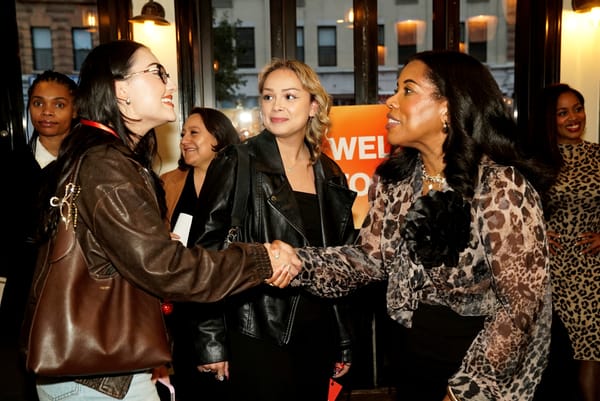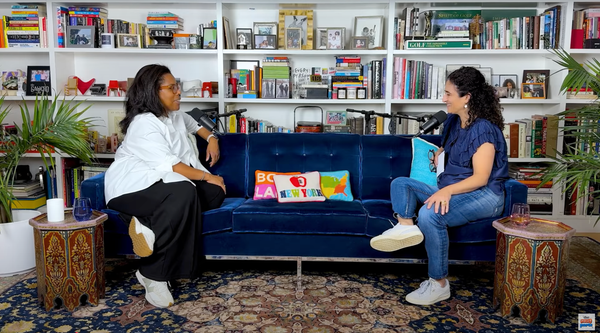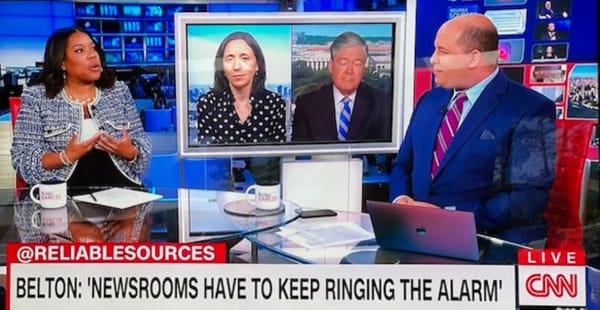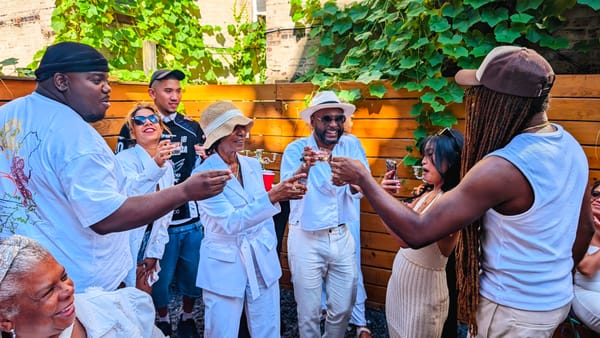'The Longer They Play, the More They Lose'
2025 came in like the beginning of the film "Casino" — with a bang.
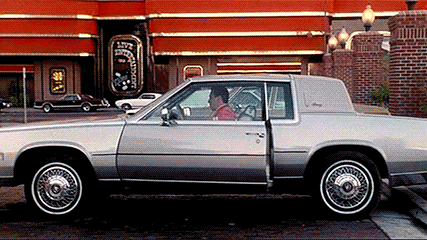
Before I ever ran a news site or got myself proverbially “blown up,” Danielle C. Belton was having a great run in media. I can tell you that.
Possibly the best run I’ve ever had.
I managed to stay employed in this volatile media market for a decade. For ten years, I did not get laid off, the news organizations I worked for did not shutter, the whole business wasn’t sold, I didn’t quit in a fit of rage, I managed to stay mentally stable and healthy, and the show wasn’t canceled.
The Substack of the Writer Formally Known As The Black Snob is a reader-supported publication. To receive new posts and support my work, consider becoming a free or paid subscriber.
Some of that was pure luck, but a lot was due to my hard work as a journalist and leader, where I kept an eye on my newsrooms like Ace Rothstein kept an eye on the Tangiers in Martin Scorsese’s 1995 epic Casino. From my perch — the desk in my walk-in closet — I lived in our Slack channels, observing all and getting involved when necessary. I delegated where possible while protecting and overseeing my personal news empires. But like Ace working for the mob in Las Vegas (he wasn’t of Italian descent or from the region but was a Midwestern Jew), I was an outsider. I didn’t go to an Ivy League School, wasn’t well-connected, and was the rare news leader who happened not to be a white man.
Nothing was guaranteed, and I served at the pleasure of those who owned the publications I led.
I’ve been in media since I graduated from Southern Illinois University Edwardsville in 1999. However, employment was rarely reliable or steady, except at the very beginning. My first three jobs came fast and somewhat easy as I went from a St. Louis-based marketing firm to two local newspapers in Texas and California. Then, I took a break after several severe mental health episodes and my fears that the intensity of my career was impacting my overall well-being. I fought my way out of the darkness and back into the light, rejoining the journalism world in 2007 when I launched my old blog — The Black Snob, but I struggled to find regular employment for over a decade. I went from nonprofit communications to news sites to TV and back again. I was a freelancer and ghostwriter in between. Without the help of my father, I might have ended up on the streets. My wages were so paltry.
Then I met Lyne Pitts, the then-managing editor of The Root, around 2014 and just kept popping up at events the website held to chat with her in hopes of landing a job. At that point, I’d been circling a potential gig there for years, befriending nearly every managing editor the organization had in its history. Pitts was the first to actually hire me as a regular freelancer (one year, I wrote more than 75 entries for The Root 100 list in less than a week because I wanted that sweet, sweet $75 a pop for each written entry), and later as an associate editor in 2015. After a year of writing, editing, and recruiting new talent, I was promoted to managing editor, then editor-in-chief, and my journey with stable employment began.
But much like Ace at the end of Casino — after a decade of full-time leadership work — it’s all over … for now.
Earlier in January, I announced that I would be leaving HuffPost shortly after my earlier message about staffing cuts to the newsroom. My leaving was intentional — I wanted to save jobs — but it was sad for me because I truly loved being a part of HuffPost and had been looking forward to participating in its 20-year anniversary.
I joined HuffPost in 2021 during a very uncertain time. It had gone without an editor-in-chief for quite a while, and BuzzFeed had just acquired it. I was the news org’s third editor-in-chief and second Black woman leader, after Lydia Polgreen.
After a round of layoffs, I was brought on that April to lead the beleaguered newsroom. But the staff didn’t know that I, too, was carrying my own scars and baggage from past experiences. HuffPost was the first media organization I led where I’d never worked as a freelancer, staff writer, or mid-level editor beforehand. I was nervous, a bit paranoid, and didn’t know who I could trust.
Still, I did my best to bond with people in a difficult virtual environment. We were still in the thick of the pandemic when I was hired, and I wouldn’t meet anyone in person — not my superiors or my staff — for months, which often made the job feel surreal. Despite this, I made an effort in good faith to bond with everyone by embarking on a 30-day listening tour, talking to various teams and individual staffers about their experiences at HuffPost and their dreams for their roles, teams, and the organization. I appreciated how so many people were honest with me about their feelings and concerns as we all began the slow process of learning to trust each other.
It wasn’t easy, though. The virtual environment was challenging for me, a people-person who thrives off the energy of interpersonal relationships and in-person engagement. When I wasn’t stressed out trying to grasp what was happening, I was often disassociating. Everything felt intangible as I would grow quiet during meetings, unsure how to engage. After some hard conversations with my then-boss, BuzzFeed’s Head of News, Mark Schoofs, and my team leads, we got past the discomfort and awkwardness that plagued those virtual interactions my first year. We began to collaborate better and trust one another.
With the advice of Schoofs, as well as my executive coach Sandra Cohen and my father, a long-time manager in the aerospace industry, echoing in my head, I decided to make the cornerstones of my leadership empathy, transparency, and consensus building based on their advice and something my father had told me years ago when I had my first management role.
No surprises.
My father preached honesty with one’s staff. He said no employee should ever be confused about where they or their team stands in the eyes of their leadership. Don’t wait until a performance review to tell someone they are struggling or missing the mark.
Schoofs encouraged trust and transparency with my team. He told me I needed to open up to them and rely on them more to succeed. Cohen highly valued empathy in leadership and coached me on healing relationships with my leads through personal transparency, communication, and better understanding.
As a result, every year until 2024, while I was the lead at HuffPost, the organization grew — in traffic, team size, diversity, and revenue. We relaunched HuffPost Voices as a multiethnic, intersectional site, adding a new vertical, Indigenous Voices, in 2022. We often reached over 330 million cross-platform pageviews monthly, including a record-breaking 565 million cross-platform pageviews in September 2024. The staff also grew from 115 to more than 130 team members. We won or were a finalist for more than 17 awards, including three ASMEs, two Writer’s Guild Awards, three Deadline Club Awards, one Goldziher Prize and LA Press Club Award apiece, and many more. In the Fall of 2023, we launched our membership program where our audience could contribute to HuffPost so it could remain free for most readers. We then revamped it, creating ad-free options for HuffPost readers this year.
Sign up for an ad-free HuffPost here and support this fearless, award-winning newsroom today!
Things were exciting. And my team was firing on all cylinders. I was imagining what our 20th anniversary would look like in 2025 while hoping for the best as we worked our way through the 2024 election. But 2024 was challenging as it dragged all its woes upon our doorstep. Misinformation and disinformation were running rampant. Social media platforms were becoming hostile to news alongside specific segments of the general public.
The news industry was not immune to the revenue struggles plaguing us everywhere in media. Newsrooms had been shuttering since the pandemic hit and continued to do so — Vice, BuzzFeed News, and so many others either shut down or had their workforce reduced radically. The revenue model was horribly broken, and advertisers were fleeing hard news in droves, not wanting their wares to be promoted next to incendiary stories about politics, violent crime, racism, or the industry’s own personal Nicky Santoro (only dumber yet somehow more dangerous) — Donald Trump.
Santoro — the man who aspired to be the mob boss of Las Vegas in Casino — was ruthless, amoral, and petty. Trump wasn’t all that different. He was also a “friend” of the media initially, much like Santoro was a “friend” to Rothstein. While some in the media believed Trump was “good” for business, I knew better. I knew there was little interest from this would-be strongman in freedom of the press, expression, and information and that he cared not for any of the various amendments in the U.S. Constitution. After 2016, he was openly at war with the press alongside his many followers. Most politicians just “pled the refs” with journalists, but in 2024, he chose scorched earth — capitulate or face his wrath. Watching organizations I’d long admired, like The Washington Post and Los Angeles Times, bend the knee to someone who actually enjoyed the comparison to ruthless mob bosses like Santoro made me feel sick. When I declared in an op-ed that we at HuffPost had no interest in caving, the newsroom and BuzzFeed stood by me, as I prepared myself to dig in my heels and fight.
Despite HuffPost’s best efforts, we were up against something much bigger and sinister — public apathy and a lack of resources. While billionaires prop up shaky media organizations on the right, most mainstream publications and more prominent news outlets are alone. They live and die by advertisers, who have essentially told much of the digital news industry to drop dead.
Fast forward to this January, while the new administration went on their Elon Musk-fueled rampage through our government programs and services, HuffPost was contending with cuts and drastic changes. And I knew I had no other choice but to leave.
It wasn’t a decision I made lightly, even though I felt it was the only one I could make.
Like many former staff writers and editors, I did not know or understand the mysteries that happen at the top of a company. I wondered what it was like, but I could only make assumptions. At that time, I thought leadership didn’t matter because so much of it was interchangeable or unknowable. What mattered were the people making the news every day. I thought it didn’t matter who led or owned something — because “bosses gonna boss” and sometimes ruin everything at their staff’s expense. It wasn’t until I saw what it was like having a “good” leader versus a “bad” one that I realized leadership was more than just the man behind the curtain. Leadership was the difference between a peaceful workplace and a terrible one.
The personality of an org starts at the top.
In my previous role at The Root, my team sometimes called me “mom.” Something I did not completely love (I was younger or the same age as some of the staffers who called me that), but I came to respect it for what it represented — they trusted me. They liked working for me. They were dedicated to The Root and its audience. And, other than the occasional petty squabble between passionate staffers over nonsense, we were a happy family where we could complain about each other but would close ranks if anyone from the outside disrespected a team member. But The Root was also small. The largest the staff ever got under me was 22 people.
At HuffPost, it was harder to bond with more than 130 people intimately, but I was up for the challenge and did my best despite being:
- Terrible at remembering people’s names and faces
- Someone who disassociates in virtual environments
I trudged forward anyway. From listening tours to office hours. From monthly letters of recognition to lunches, happy hours, and trips to Washington, D.C. and Los Angeles to meet with my team. To dinners and work functions. Over time, we forged an incredible bond. However, I often wondered if my team felt the same about me as I did about them. Part of being in leadership is that most leaders get very little feedback — good or bad. And I craved connection. And no matter how close you are with your team, unless it’s a small one like I had at The Root, it’s hard for more junior staffers to feel comfortable telling their boss of bosses what they actually think.
Still, with the help of my leadership team, we made it work, and we were successful for three glorious years. I greatly valued the intelligence, guts, guidance, and insight of my executive editors, Kate Palmer and Whitney Snyder, veterans of the HuffPost newsroom, and our operations lead, Marta Rodriguez, who was my right hand throughout my tenure. It worked, and the four of us teamed up to make HuffPost a great place to be. Because the heart of that newsroom is so beautiful and pure — it’s worth protecting. And that’s what I tried to do the entire time I was there: championing our work, protecting my team, and lobbying for more resources. Because I didn’t see myself as “the boss,” I saw myself as in service of the newsroom, just as my team saw themselves as in service of the audience.
It sucks that you have to leave to find out what people actually think of you. But I was overwhelmed by my team’s response. So many thanked me for my years of leadership and willingness to step down to save jobs. So many told me that seeing a Black woman as the lead inspired them and their careers. We were all human. Ultimately, we all made sacrifices to protect something we built together.
HuffPost had its buyouts and layoffs the first week of February, shortly after my last day on Friday, January 31st. I deleted Slack on February 2nd. I stopped checking my work email shortly after. And then, in a matter of days, I was finally removed from most company systems.
It was over.
What I’m going to do next? I don’t know. I’ll probably take a month or two off to decompress from everything. After all, I was preparing my very “knuck if you buck” approach for Trump 2: MAGA-boogaloo, and now I feel like Ace Rothstein, flying through the air after someone put a bomb underneath his 1981 Cadillac Eldorado Biarritz. Because it all happened so quickly — the crisis, my decision, the cuts — there was no time to absorb what was happening. The year came in very “grand opening, grand closing” for everyone.
But I’ll always be rooting for HuffPost. (Sign up for their membership program here!) And I’m grateful for my time there and at BuzzFeed. I learned so much — about leadership, about myself.
And while I may have rejoined the ranks of those sans jobs, I am optimistic that there is something even more special out there waiting for me. I know that I’m wanted and needed and that no job defines any one person.
To paraphrase, at the end of Casino:
After a decade of employment, in the end, I wound up right back where I started. I could still write and edit, and I could still make money by knowing what people liked to read. And why mess up a good thing?
And that’s that.
The Substack of the Writer Formally Known As The Black Snob is a reader-supported publication. To receive new posts and support my work, consider becoming a free or paid subscriber.
